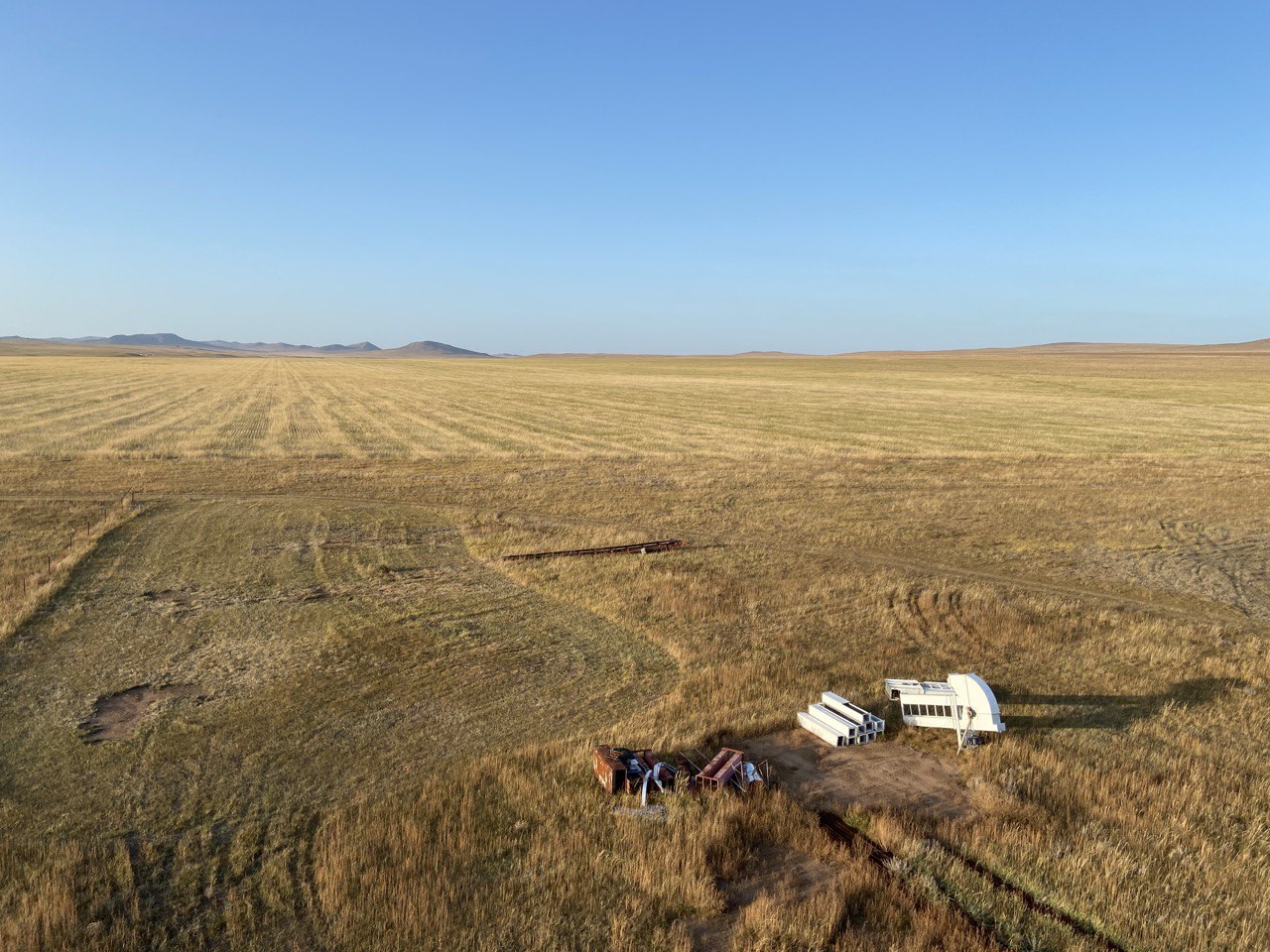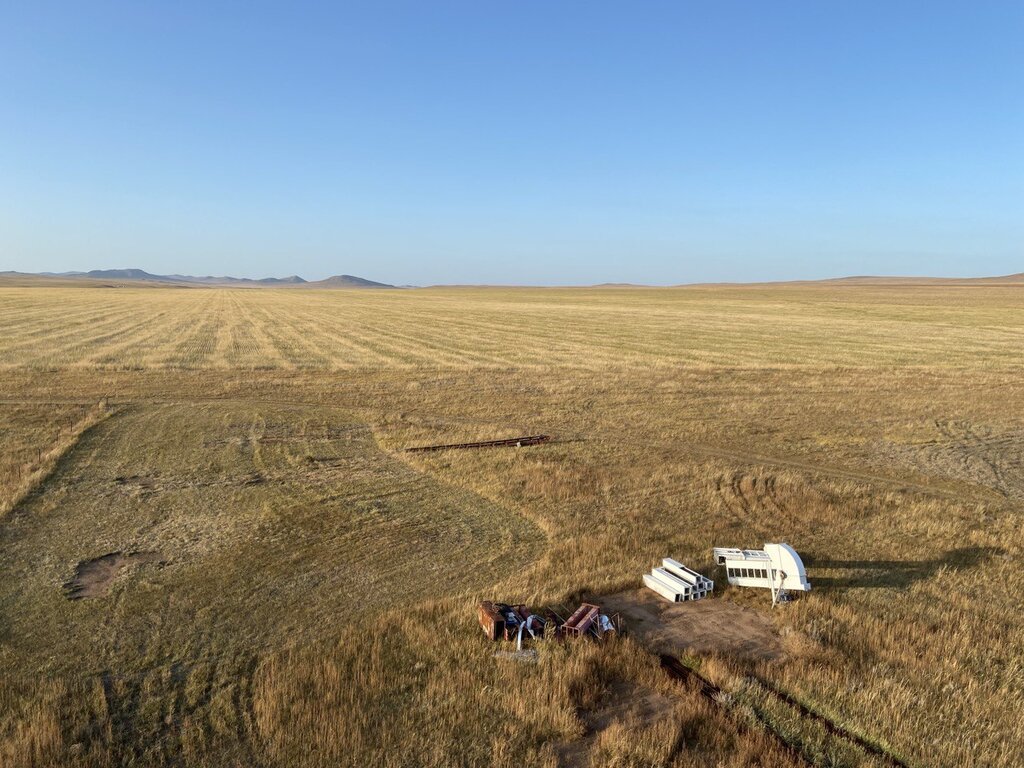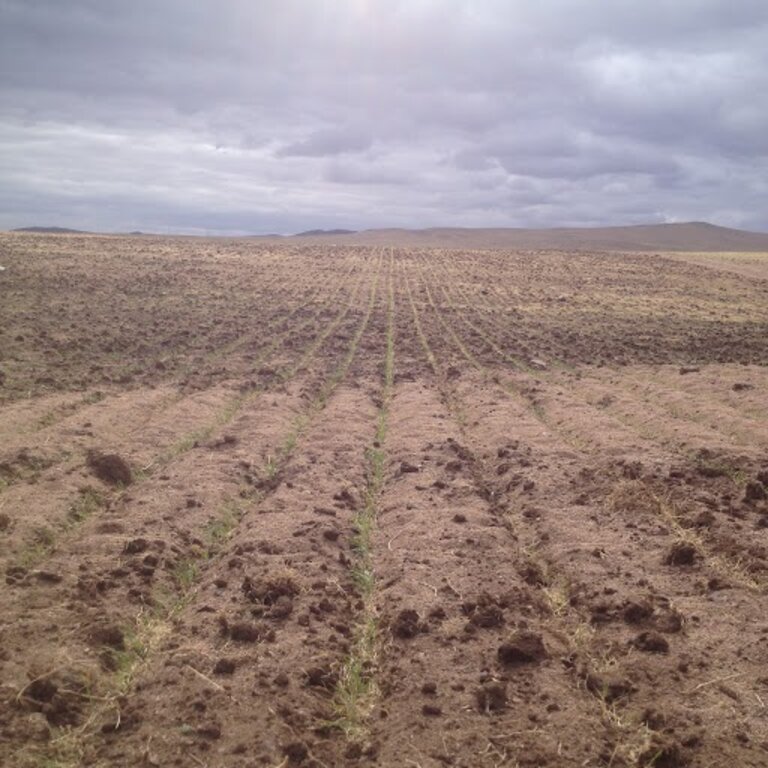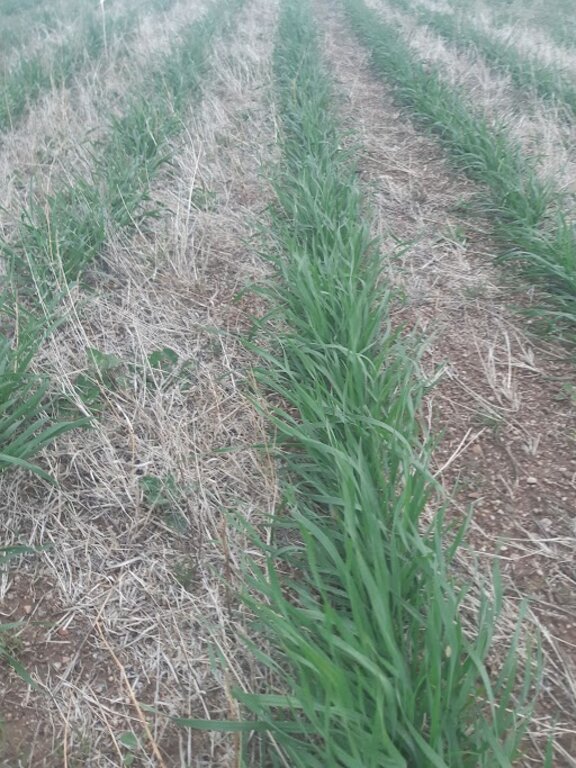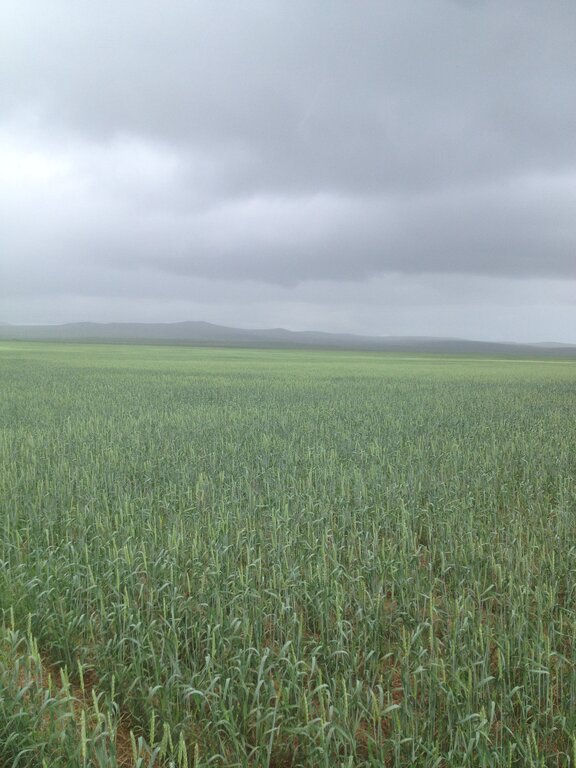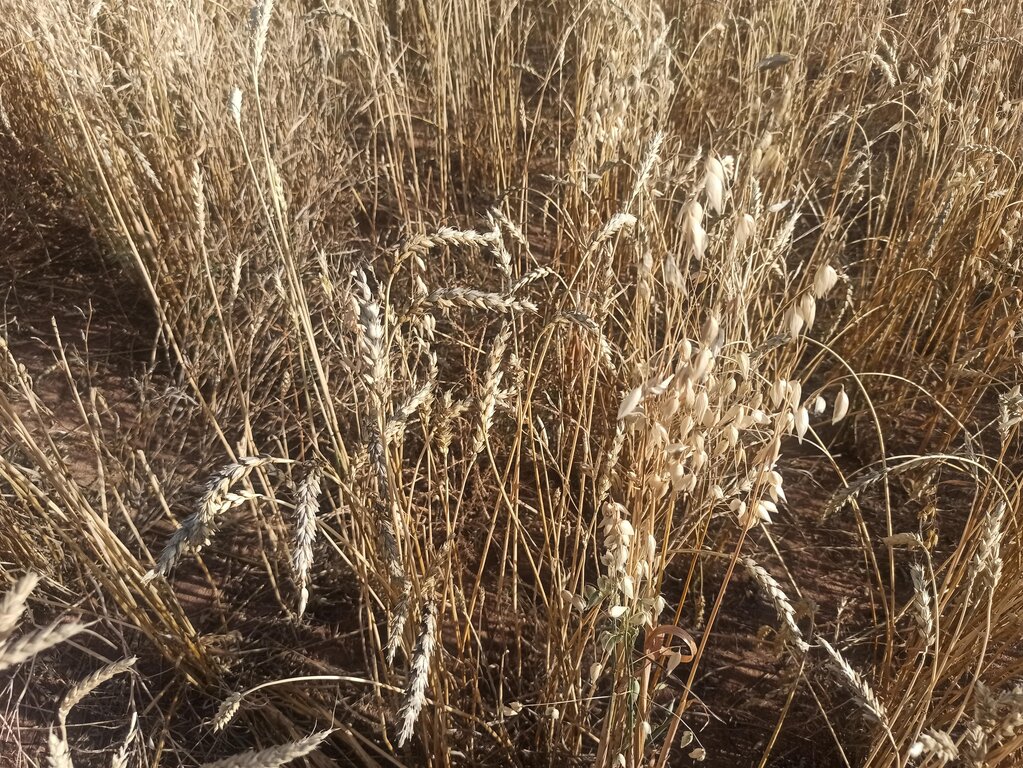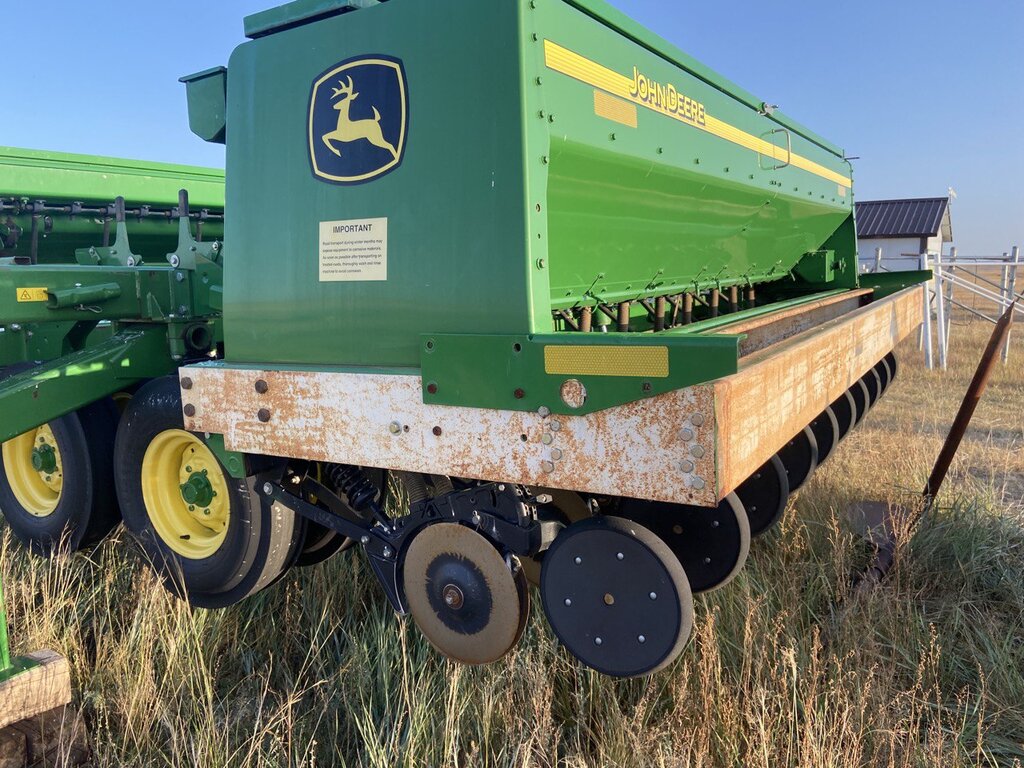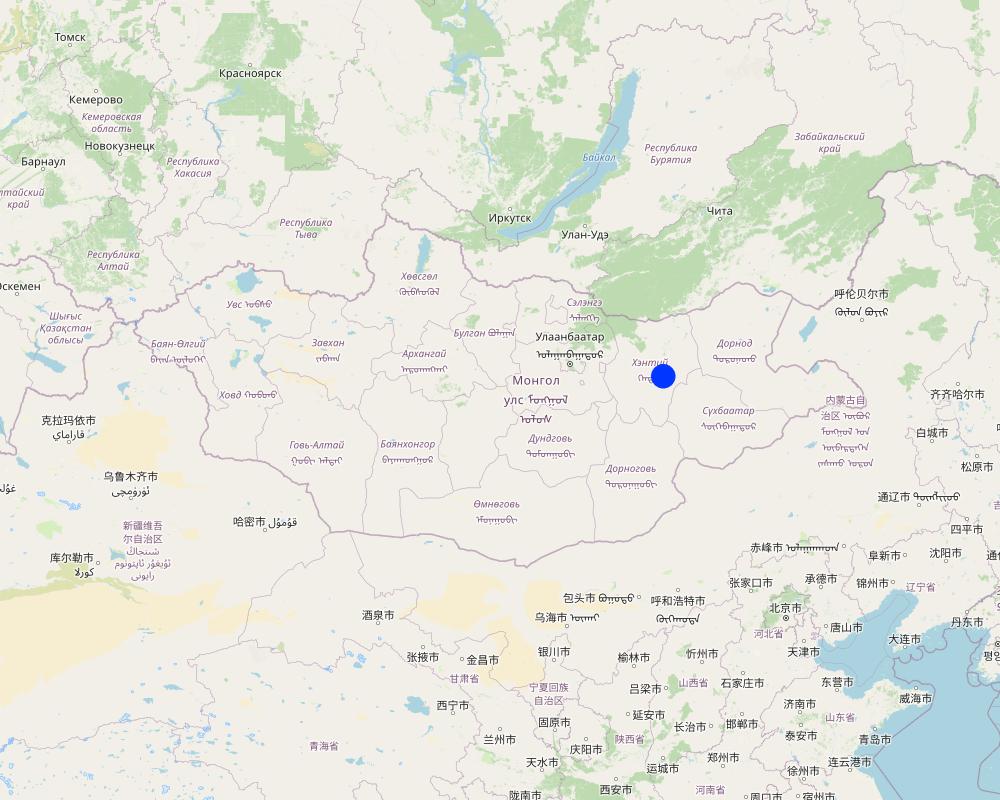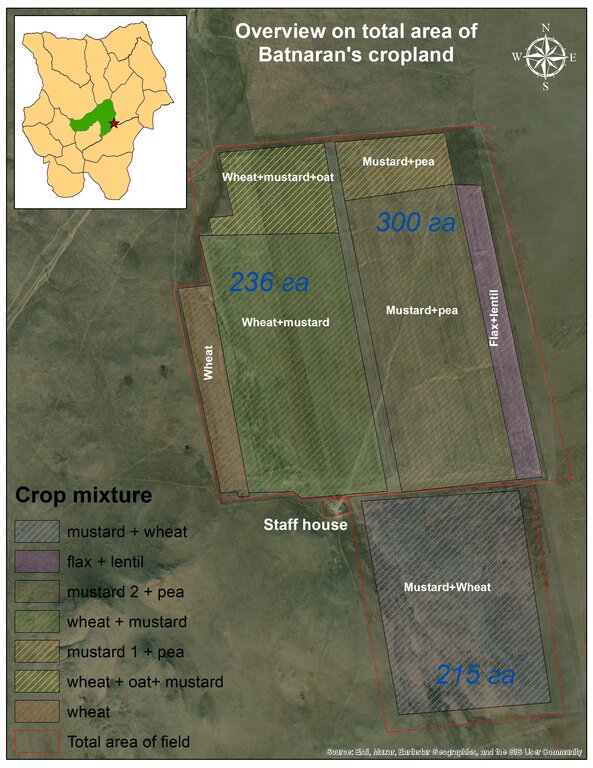Conservation agriculture to restore abandoned cropland [ប្រទេសម៉ុងហ្គោលី]
- ការបង្កើត៖
- បច្ចុប្បន្នភាព
- អ្នកចងក្រង៖ Otgontsetseg Davaanyam
- អ្នកកែសម្រួល៖ Mandakh Nyamtseren
- អ្នកត្រួតពិនិត្យ Rima Mekdaschi Studer
Khurs Khamgaalliin gazar tarialan
technologies_6938 - ប្រទេសម៉ុងហ្គោលី
ពិនិត្យមើលគ្រប់ផ្នែក
ពង្រីកមើលទាំងអស់ បង្រួមទាំងអស់1. ព័ត៌មានទូទៅ
1.2 ព័ត៌មានលម្អិតពីបុគ្គលសំខាន់ៗ និងស្ថាប័នដែលចូលរួមក្នុងការវាយតម្លៃ និងចងក្រងឯកសារនៃបច្ចេកទេស
បុគ្គលសំខាន់ម្នាក់ (ច្រើននាក់)
អ្នកប្រើប្រាស់ដី:
Batdeleg Batnaran
Khentiin Tarialan LLC
ប្រទេសម៉ុងហ្គោលី
ឈ្មោះគម្រោងដែលបានចងក្រងឯកសារ/ វាយតម្លៃលើបច្ចេកទេស (បើទាក់ទង)
Decision Support for Mainstreaming and Scaling out Sustainable Land Management (GEF-FAO / DS-SLM)ឈ្មោះអង្គភាពមួយ (ច្រើន) ដែលបានចងក្រងឯកសារ/ វាយតម្លៃបច្ចេកទេស (បើទាក់ទង)
Mongolian Academy of Sciences, Institute of Geography and Geoecology (IGG) - ប្រទេសម៉ុងហ្គោលី1.3 លក្ខខណ្ឌទាក់ទងទៅនឹងការប្រើប្រាស់ទិន្នន័យដែលបានចងក្រងតាមរយៈ វ៉ូខេត
អ្នកចងក្រង និង(បុគ្គលសំខាន់ៗ)យល់ព្រមទទួលយកនូវលក្ខខណ្ឌនានាទាក់ទងទៅនឹងការប្រើប្រាស់ទិន្នន័យដែលបានចងក្រងតាមរយៈវ៉ូខេត:
បាទ/ចា៎
1.4 សេចក្តីប្រកាសស្តីពីចីរភាពនៃការពណ៌នាពីបច្ចេកទេស
តើបច្ចេកទេសដែលបានពណ៌នានេះមានបញ្ហាដែលផ្តោតលើការធ្លាក់ចុះគុណភាពដី, បើដូច្នេះវាមិនអាចត្រូវបានប្រកាសថាជាបច្ចេកទេសនៃការគ្រប់គ្រងប្រកបដោយចីរភាពទេ?
ទេ
មតិយោបល់:
This technology is a SLM technology, because it returned abandoned land to productive agricultural land while building up soil health.
1.5 ការយោងទៅលើកម្រងបញ្ជីសំណួរ (មួយ ឬច្រើន) នៃវិធីសាស្ត្រផ្សព្វផ្សាយ SLM (ដែលបានចងក្រងដោយទស្សនៈពិភពលោកស្តីពីវិធីសាស្ត្រ និងបច្ចេកទេសងអភិរក្ស WOCAT)
2. ការពណ៌នាពីបច្ចេកទេស SLM
2.1 ការពណ៌នាដោយសង្ខេបពីបច្ចេកទេស
និយមន័យបច្ចេកទេស:
This technology aimed to restore abandoned cropland which was used for crop and fodder production during the 1970s-1980s. Since 2016, the farmer applied conservation agriculture and mixed cropping to reduce land degradation, revive cropping practices, increase land productivity for agriculture and enhance soil health.
2.2 ការពណ៌នាលម្អិតពីបច្ចេកទេស
ការពណ៌នា:
The land in Kherlen soum, Khentii province, spanning 500 hectares, was used for crop production and later for producing fodder for livestock. However, since 1984, it has been left abandoned. To rehabilitate the area and revive cropland, conservation agriculture combined with mixed cropping was introduced in 2014.
Mixed cropping encompasses various agrotechnical practices that involve the cultivation of different crops together, making use of their ability to interact with each other. The aim is to sustain crop yield in regions with limited moisture, protect the soil surface, regulate soil moisture levels, and enhance the availability of micro and macro-nutrients. In Kherlen soum, Khentii province, mixed cropping was implemented by planting seed mixtures of different proportions, taking into consideration the specific requirements and differences among various crops. Presently, annual crops such as mustard, peas, Cape rice, and wheat, rye along with rapeseeds, are successfully cultivated mixed and/or in rotation in the area.
Conservation agriculture in soil protection agriculture offers several advantages, including the enhancement of soil, its resilience to external factors such as erosion by wind, regulation of soil fertility and microorganism populations, avoidance of highly toxic substances in agriculture, and increased productivity. One significant aspect of conservation agriculture is using no-till and direct sowing techniques to minimize soil disturbance. During harvesting, only the crop heads are collected, while the remaining rootsystems and stems are left in and above the soil contributing to increasing soil organic matter. Other residues and parts of plants, such as straw/ stalks and leaves, are shredded and spread across the field to reduce soil moisture evaporation and protect it from the sun and wind. Soil erosion by wind can be mitigated by covering the soil as much and long as possible either by leaving the crop residues on the soil and/or including cover crops into crop rotations. Furthermore, this technology improves the soil health and microenvironment/ microclimate.
To initiate and implement this technology, the land user leased most of his land through a proposal, aimed at improving the soil quality of abandoned land, to the local government, and also purchased a certain amount of land through a land auction announced on the government website. Initial preparation of land for sowing consisted of removing stones from the field and spraying herbicides to get rid of weeds and their seeds. A minimal dose of herbicides with low toxicity is used to control the growth and spread of weed plants commonly found in abandoned fields. Later on mustard was incorporated into mixed cropping and rotations suppressing the growth of weed.
In the first year, the farmer planted a mixture of mustard, oilseed rape and lucerne to enhance soil penetration and break up compacted soil, as well as wheat in a 40 cm strip on stony soil with low fertility. First few years 2014-2018), the farmer didn’t harvest all the yields to keep the soil covered and improve the soil quality.
In 2019 the farmer built a fence to protect against grazing and yields significantly improved. Moreover, various equipment such as direct seeder for no till or minimum tillage crop cultivation, combine harvester, tractor, herbicide spraying machine and seed sorting machines to improve the quality of produce for the market (clean and separate seeds of different sizes and different types of crops) were bought with a bank loan.
A comprehensive knowledge of the interactions and symbiotic relationships between different crops is also essential to plan for crop mixtures and rotations. Crop morphology such as root system, competition for nutrients and water should be considered. Mustard-pea mixture facilitates harvesting as pea is difficult to harvest in monoculture and mustard can provide biological weed control.
He divided the land / field into 12 plots, which were planted with different crop mixtures and in rotation, maintaining soil fertility, limiting pests and diseases, and increasing crop yields. Legumes can improve soil fertility by adding nitrogen to the soil. The farmer practiced five-field rotation in his cropland using legumes including pea, bean, lentils and alfalfa. The rotation plan depends on climate conditions.
The levels of potassium and phosphorous in the soil were monitored and regularly measured. Only when a deficit occurred the land user used mineral fertilizers.
According to farmers who practice conservation agriculture and mixed farming, these technologies effectively maintains soil stability, ensuring its long-term sustainability.
2.3 រូបភាពនៃបច្ចេកទេស
2.5 ប្រទេស/តំបន់/ទីតាំងកន្លែង ដែលបច្ចេកទេសត្រូវបានអនុវត្ត និងបានគ្រប់ដណ្តប់ដោយការវាយតម្លៃនេះ
ប្រទេស:
ប្រទេសម៉ុងហ្គោលី
តំបន់/រដ្ឋ/ខេត្ត:
Khentii province
បញ្ជាក់បន្ថែមពីលក្ខណៈនៃទីតាំង:
Kherlen soum, Takhilgat bag
បញ្ជាក់ពីការសាយភាយនៃបច្ចេកទេស:
- ត្រូវបានផ្សព្វផ្សាយត្រឹមតំបន់មួយ
ប្រសិនបើបច្ចេកទេសត្រូវបានសាយភាយពាសពេញតំបន់ណាមួយ បញ្ជាក់ទំហំផ្ទៃដីអនុវត្តន៍ (គិតជា គ.ម2):
8,0
ប្រសិនបើមិនច្បាស់ពីទំហំផ្ទៃដី សូមធ្វើការប៉ាន់ប្រម៉ាណ:
- 1-10 គម2
តើបច្ចេកទេស (មួយ ឬច្រើន) ទាំងនោះស្ថិតនៅក្នុងតំបន់ការពារជាអចិន្ត្រៃយ៍ណាមួយដែរឬទេ?
ទេ
មតិយោបល់:
The area is not a part of the permanently protected area.
Map
×2.6 កាលបរិច្ឆេទនៃការអនុវត្ត
បង្ហាញឆ្នាំនៃការចុះអនុវត្ត:
2014
ប្រសិនបើមិនច្បាស់ឆ្នាំ សូមបញ្ជាក់កាលបរិច្ឆេទដែលប្រហាក់ប្រហែល:
- តិចជាង 10ឆ្នាំមុន (ថ្មី)
2.7 ការណែនាំពីបច្ចេកទេស
សូមបញ្ជាក់តើបច្ចេកទេសត្រូវបានណែនាំឱ្យអនុវត្តដោយរបៀបណា:
- តាមរយៈការបង្កើតថ្មីរបស់អ្នកប្រើប្រាស់ដី
- ពេលកំពុងពិសោធន៍
មតិយោបល់ (ប្រភេទនៃគម្រោង ។ល។):
The farmer planted mustard, rapeseed, and alfalfa in rotation and mixture based on national and international experiences and research on conservation agriculture. These plants have taproot systems that penetrate the soil, enhance water uptake from lower soil depth and make the hardpan soil more porous. After implementing this technology, the land user observed and monitored the field himself. He observed that the retention of soil moisture has increased, soil erosion has significantly decreased, and biological diversity, including microorganisms, insects, and birds, has also increased due to the presence of cover plants.
3. ចំណាត់ថ្នាក់នៃបច្ចេកទេស SLM
3.1 គោលបំណងចម្បង (១ ឬច្រើន) នៃបច្ចេកទេសនេះ
- ធ្វើឱ្យប្រសើរឡើងនូវផលិតកម្ម
- កាត់បន្ថយ, បង្ការ, ស្តារឡើងវិញនូវការធ្លាក់ចុះគុណភាពដី
- អភិរក្ស/ធ្វើឱ្យប្រសើរឡើងជីវចម្រុះ
- បន្ស៊ាំទៅនឹងការប្រែប្រួលអាកាសធាតុ/គ្រោះមហន្តរាយ និងផលប៉ះពាល់របស់វា
- បង្កើតផលប្រយោជន៍សេដ្ឋកិច្ច
3.2 ប្រភេទដីប្រើប្រាស់មួយប្រភេទ (ច្រើនប្រភេទ) ដែលបានអនុវត្តបច្ចេកទេស
ដីប្រើប្រាស់ចម្រុះនៅលើដីតែមួយ:
ទេ

ដីដាំដំណាំ
- ដំណាំប្រចាំឆ្នាំ
ដំណាំប្រចាំឆ្នាំ - បញ្ជាក់ប្រភេទដំណាំ:
- ធញ្ញជាតិ - ស្រូវ
- ធញ្ញជាតិ - ស្រូវសាលី
- ធញ្ញជាតិ - ស្រូវសាលី (និទាឃរដូវ)
- ដំណាំសរសៃ - ដើមកម្បាស ដើមក្រចៅ ផ្សេងៗ
- ដំណាំចំណីសត្វ - alfalfa
- legumes and pulses - lentils
- ពពួកសណ្តែក - គ្រាប់ហោឡាំងតាវ
- ដំណាំដែលមានគ្រាប់ចម្រាញ់ប្រេងបាន - ផ្កាឈូករ័ត្ន ផ្កា rapeseed ផ្សេងៗ
- ដំណាំយកគ្រាប់ - ល្ង គ្រាប់ផ្កាប៉ុបពី មូតាដ ផ្សេងៗ
ប្រព័ន្ធដាំដុះដំណាំប្រចាំឆ្នាំ:
ដំណាំស្រូវសាលី ឬប្រហែលវិលជុំជាមួយស្រូវ/ស្មៅ
ចំនួនសារដែលដាំដំណាំក្នុងមួយឆ្នាំ:
- 1
សូមបញ្ជាក់:
Plant seeds are sown in April and harvested in August to September.
តើជាការអនុវត្តន៍ដំណាំចន្លោះ?
ទេ
តើជាការអនុវត្តន៍ដំណាំវិលជុំ?
បាទ/ចា៎
បើបាទ/ច៎ា សូមបញ្ជាក់:
Entire field/ area was divided into 5 main sections, allowing to practice crop rotation. In general, a rotation consists of cereal crops follow by broad leaved crops. Within one plot, the land user decides the mixture of crop depending on the weather condition in the year. If a mixture of mustard-wheat was planted in this year, another crop mixture should be planted in the next year.
3.3 បន្ទាប់ពីអនុវត្តបច្ចេកទេស តើដីប្រើប្រាស់មានការប្រែប្រួលដែររឺទេ?
បន្ទាប់ពីអនុវត្តបច្ចេកទេស តើដីប្រើប្រាស់មានការប្រែប្រួលដែររឺទេ?
- បាទ/ច៎ា (សូមបំពេញសំណួរខាងក្រោមពីស្ថានភាពដីប្រើប្រាស់មុនពេលអនុវត្តបច្ចេកទេស)
ដីប្រើប្រាស់ចម្រុះនៅលើដីតែមួយ:
ទេ

ដីខ្សោះជីជាតិ
សូមបញ្ជាក់:
Abandoned land
កំណត់សម្គាល់:
Monoculture crops were planted in the area during the socialist period, and it was left unused and abandoned since 1986. Therefore, the productivity and fertility of the land decreased.
3.4 ការផ្គត់ផ្គង់ទឹក
ការផ្គត់ផ្គង់ទឹកនៅកន្លែងអនុវត្តបច្ចេកទេស:
- ទឹកភ្លៀង
មតិយោបល់:
Irrigation systems are not used throughout the field.
3.5 ក្រុម SLM ដែលបច្ចេកទេសស្ថិតនៅក្នុង
- ប្រព័ន្ធដំណាំបង្វិល (ការដាំដំណាំវិលជុំ ការទុកដីចោលដើម្បីបង្កើនជីជាតិ កសិកម្មពនេចរ)
- ធ្វើឱ្យប្រសើរឡើងគម្របដី/ ដំណាំគម្របដី
- កាត់បន្ថយការរំខានដល់ដី
3.6 វិធានការ SLM ដែលបញ្ចូលនូវបច្ចេកទេស

វិធានការក្សេត្រសាស្ត្រ
- A1: ដំណាំ/គម្របដី
- A2: សារធាតុសរីរាង្គ/ជីជាតិដី
- A3: ការរក្សាស្រទាប់ដីខាងលើ
- A5: ការគ្រប់គ្រងគ្រាប់ពូជ បង្កើនប្រភេទពូជ
- A6: ការគ្រប់គ្រងកាកសំណល់
A3: ប្រព័ន្ធភ្ជួររាស់ខុសៗគ្នា:
A 3.1: មិនភ្ជួររាស់
A6: បញ្ជាក់ពីការគ្រប់គ្រងកាកសំណល់:
A 6.4: រក្សាទុក

វិធានការគ្រប់គ្រង
- M1: ការផ្លាស់ប្តូរប្រភេទដីប្រើប្រាស់
មតិយោបល់:
Abandoned land had been converted into annual cropland. According to the classification of Mongolian Land Unified Fund, land was classified as abandoned land and changed into agricultural land after starting to use it.
3.7 កំណត់ប្រភេទនៃការធ្លាក់ចុះគុណភាពដីសំខាន់ៗដែលបច្ចេកទេសនេះបានដោះស្រាយ

ការបាត់ដីដោយសារខ្យល់
- Et: ការបាត់បង់ដីស្រទាប់លើ
- Eo: ផលប៉ះពាល់នៃការធ្លាក់ចុះគុណភាព

ការធ្លាក់ចុះសារធាតុគីមីក្នុងដី
- Cn: ការថយចុះជីជាតិ និងកាត់បន្ថយបរិមាណសារធាតុសរីរាង្គ (មិនកើតឡើងដោយការហូរច្រោះទេ)

ការធ្លាក់ចុះជីវសាស្ត្រនៃដី
- Bc: ការថយចុះនូវគម្របរុក្ខជាតិ
- Bq: ការថយចុះនូវជីវម៉ាស/ បរិមាណ
- Bs: សមាសភាពដែលមានគុណភាពនិងប្រភេទសត្វ/ការថយចុះនូវជីវចម្រុះ
មតិយោបល់:
The soil in the abandoned land became infertile due to water and wind erosion, and thus, there had been a decrease in biodiversity in the soil as well as in plant diversity and productivity.
3.8 ការពារ កាត់បន្ថយ ឬស្តារឡើងវិញនៃការធ្លាក់ចុះគុណភាពដី
បញ្ជាក់ពីគោលដៅរបស់បច្ចេកទេស ដែលផ្តោតទៅការធ្លាក់ចុះគុណភាពដី:
- ការជួសជុល/ ស្តារឡើងវិញនៃឱនភាពដីធ្ងន់ធ្ងរ
មតិយោបល់:
The technology aims to revive the agricultural practice in abandoned cropland, protect the soil from erosion, enhance its moisture and organic matter, and improve biological diversity by planting a variety of plants, thereby allowing opportunities for long-term sustainable use.
4. បច្ចេកទេសជាក់លាក់ សកម្មភាពអនុវត្ត ធាតុចូល និងថ្លៃដើម
4.1 គំនូសបច្ចេកទេសនៃបច្ចេកទេសនេះ
លក្ខណៈពិសេសនៃបច្ចេកទេស (ទាក់ទងនឺងគំនូរបច្ចេកទេស):
This diagram shows how the crop mix was distributed across the field in 2023 (on different plots). Entire field was divided into 5 main sections which are intended for crop rotation and also several small sections which are for ensuring seed source. More than 20 types of crops were planted in the whole field. A five-field rotation is practiced in this cropland with a sequence of cereal grains (wheat, barley, oats, etc.) followed by leafy plants (flax, lentils, peas, mustard, etc.), depending on the climatic conditions of the year. In dry years, the land user prefers to grow cereals and flax, which are more resistant to drought, and then rotate cereals with a mixture of leafy plants the following year. In years with good humidity, on the other hand, a mixture of mustard + peas + oats + lentils is suitable. The advantages of this mixture is to improve soil fertility and to control diseases and pest. In addition, soil remains covered against soil erosion. Inclusion of different crops means also increase in agrobiodiversity.
ឈ្មោះអ្នកនិពន្ធ:
Ankhbayar N., Gereltuya G.
កាលបរិច្ឆេទ:
02/10/2023
4.2 ព័ត៌មានទូទៅដែលពាក់ព័ន្ធនឹងការគណនាធាតុចូល និងថ្លៃដើម
កំណត់របៀបនៃការគណនាថ្លៃដើម និងធាតុចូល:
- ក្នុងតំបន់អនុវត្តបច្ចេកទេស
កំណត់ទំហំ និងឯកត្តាផ្ទៃដី:
800 ha
ផ្សេងៗ/ រូបិយប័ណ្ណជាតិ (បញ្ជាក់):
Tugrik
បើពាក់ព័ន្ធសូមកំណត់អត្រាប្តូរប្រាក់ពីដុល្លាទៅរូបិយប័ណ្ណតំបន់ (ឧ. 1 ដុល្លារ = 79.9 រៀលនៃរូបិយប័ណ្ណប្រេស៊ីល) ៖ 1 ដុល្លារ =:
3453,0
កំណត់ថ្លៃឈ្នួលជាមធ្យមនៃការជួលកម្លាំងពលកម្មក្នុងមួយថ្ងៃ:
50000 - 100000 Tugrik
4.3 សកម្មភាពបង្កើត
| សកម្មភាព | រយៈពេល (រដូវកាល) | |
|---|---|---|
| 1. | Build fence | before sowing |
| 2. | Prepare (picking stones) and plough land | before sowing |
| 3. | Buy and spray herbicide | before sowing |
| 4. | Purchase tractor | before sowing |
| 5. | Purchase direct seeder | before sowing |
| 6. | Purchase combine harvester | before sowing |
| 7. | Purchase spray machine | before sowing |
| 8. | Purchase seed cleaning machine | before sowing |
| 9. | Purchase stone picker machine | before sowing |
| 10. | Purchase or rent pile machine for fencing | before sowing |
| 11. | Purchase silos | before harvesting |
| 12. | Storage shed | before harvesting |
មតិយោបល់:
Establishing a fence before the technology is an essential activity to protect from grazing and retain cover plants. The farmer empahsized that it is important to choose materials with good quality for building fence. He used imported fencing material from Canada of which the price was higher than average local market price.
4.4 ថ្លៃដើម និងធាតុចូលដែលត្រូវការសម្រាប់ការបង្កើតបច្ចេកទេស
| បញ្ជាក់ពីធាតុចូល | ឯកតា | បរិមាណ | ថ្លៃដើមក្នុងមួយឯកតា | ថ្លៃធាតុចូលសរុប | % នៃថ្លៃដើមដែលចំណាយដោយអ្នកប្រើប្រាស់ដី | |
|---|---|---|---|---|---|---|
| កម្លាំងពលកម្ម | Build fence | person | 2,0 | 15000000,0 | 30000000,0 | 100,0 |
| កម្លាំងពលកម្ម | Spray herbicide | person | 2,0 | 350000,0 | 700000,0 | 100,0 |
| កម្លាំងពលកម្ម | Sowing | person | 1,0 | 4000000,0 | 4000000,0 | 100,0 |
| កម្លាំងពលកម្ម | Stone picking | person | 1,0 | 4800000,0 | 4800000,0 | 100,0 |
| សម្ភារៈ | Tractor | piece | 1,0 | 220000000,0 | 220000000,0 | 100,0 |
| សម្ភារៈ | Direct seeder | piece | 1,0 | 224000000,0 | 224000000,0 | 100,0 |
| សម្ភារៈ | Combine harvester | piece | 2,0 | 397000000,0 | 794000000,0 | 100,0 |
| សម្ភារៈ | Agriculture spray machine | piece | 1,0 | 170000000,0 | 170000000,0 | 100,0 |
| សម្ភារៈ | Stone picker machine | piece | 1,0 | 15000000,0 | 15000000,0 | 100,0 |
| សម្ភារៈ | Seed cleaning machine | piece | 3,0 | 35000000,0 | 105000000,0 | 100,0 |
| សម្ភារៈ | Pile machine for fencing | piece | 1,0 | 6900000,0 | 6900000,0 | 100,0 |
| សម្ភារៈ | Silos | tonnes (holding capacity) | 700,0 | 714285,72 | 500000004,0 | 100,0 |
| សម្ភារៈដាំដុះ | Seeds first year | tonnes | 70,5 | 4400000,0 | 310200000,0 | 100,0 |
| ជី និងសារធាតុពុល | Herbicide | l | 2400,0 | 8000,0 | 19200000,0 | 100,0 |
| សម្ភារៈសាងសង់ | Poles and net for fence | km | 25,0 | 10800000,0 | 270000000,0 | 100,0 |
| ផ្សេងៗ | Land lease | ha | 800,0 | 500000,0 | 400000000,0 | 100,0 |
| ថ្លៃដើមសរុបក្នុងការបង្កើតបច្ចេកទេស | 3073800004,0 | |||||
| ថ្លៃដើមសរុបក្នុងការបង្កើតបច្ចេកទេសគិតជាដុល្លារ | 890182,45 | |||||
មតិយោបល់:
The implementation of conservation agriculture and mixed cropping was self-funded by land user. For certain initial investments he took a loan from the bank. The fence materials were imported from Canada, for its good quality.
4.5 សកម្មភាពថែទាំ
| សកម្មភាព | ពេលវេលា/ ភាពញឹកញាប់ | |
|---|---|---|
| 1. | Sowing/ direct seeding | April to May per year |
| 2. | Harvesting and separating harvested seeds | once in August to September |
| 3. | Reproducing seed for own use and sowing | after harvest |
| 4. | Spray herbicide | if necessary, once in 2-3 year |
| 5. | Monitoring on plant development (e.g. germination, flowering, maturity) | at each plant development stage |
| 6. | Monitoring soil fertility | once a year, in August |
មតិយោបល់:
Soil samples are taken and sent to a specialized laboratory for analysis.
4.6 កំណត់ថ្លៃដើមសម្រាប់ការថែទាំ/ សកម្មភាពរបស់បច្ចេកទេស (ក្នុងរយៈពេលមួយឆ្នាំ)
| បញ្ជាក់ពីធាតុចូល | ឯកតា | បរិមាណ | ថ្លៃដើមក្នុងមួយឯកតា | ថ្លៃធាតុចូលសរុប | % នៃថ្លៃដើមដែលចំណាយដោយអ្នកប្រើប្រាស់ដី | |
|---|---|---|---|---|---|---|
| កម្លាំងពលកម្ម | Spray herbicide | person | 2,0 | 1400000,0 | 2800000,0 | 100,0 |
| កម្លាំងពលកម្ម | Harvesting | person | 4,0 | 1500000,0 | 6000000,0 | 100,0 |
| កម្លាំងពលកម្ម | Separating seeds | person | 2,0 | 1000000,0 | 2000000,0 | 100,0 |
| កម្លាំងពលកម្ម | Sowing seeds | person | 2,0 | 1500000,0 | 3000000,0 | 100,0 |
| សម្ភារៈ | Spare parts and maintenance of machines | ha | 800,0 | 10500,0 | 8400000,0 | 100,0 |
| សម្ភារៈ | Spraying machine (fuel) | l/year | 400,0 | 2400,0 | 960000,0 | 100,0 |
| សម្ភារៈ | Sowing machine (fuel) | l/year | 4000,0 | 2400,0 | 9600000,0 | 100,0 |
| សម្ភារៈ | Combine harvesting machine (fuel) | l/year | 4000,0 | 2400,0 | 9600000,0 | 100,0 |
| សម្ភារៈដាំដុះ | Seeds | tonne/year | 13,7 | 4400000,0 | 60280000,0 | 100,0 |
| ជី និងសារធាតុពុល | Herbicide (different types) | l | 1,0 | 30000,0 | 30000,0 | 100,0 |
| ផ្សេងៗ | Land use tax | MNT/year | 1,0 | 1900000,0 | 1900000,0 | 100,0 |
| ផ្សេងៗ | Soil sampling and testing | MNT/year | 1,0 | 830000,0 | 830000,0 | 100,0 |
| ថ្លៃដើមសរុបសម្រាប់ការថែទាំដំណាំតាមបច្ចេកទេស | 105400000,0 | |||||
| ថ្លៃដើមសរុបសម្រាប់ការថែទាំដំណាំតាមបច្ចេកទេសគិតជាដុល្លារ | 30524,18 | |||||
មតិយោបល់:
The amount of herbicide used in a given year depends on the type of weed and its distribution. Initially, the land user spent 19 million (2400 litres) on herbicide to prepare the field for cultivation, and the price was relatively low compared to today (8000 MNT on average). But, in 2022, different types of herbicides were bought for different types of weeds distributed in the field and 120 million MNT (1800 litres) were spent because the price became high compared to other years due to the border closure (COVID). But in 2023, only 30 000 MNT (1 litre) was spent on herbicides in the whole field.
The land user and a permanent help receive a monthly salary.
4.7 កត្តាសំខាន់បំផុតដែលមានឥទ្ធិពលដល់ការចំណាយ
ពណ៌នាពីកត្តាប៉ះពាល់ចម្បងៗទៅលើថ្លៃដើម:
Factors that mainly affect the cost are inflation and the MNT exchange rate (mainly relevant when purchasing imported products). In addition, in the event of extreme weather and disastrous conditions, extra labor may be required to mitigate damage.
5. លក្ខណៈបរិស្ថានធម្មជាតិ និងមនុស្ស
5.1 អាកាសធាតុ
បរិមាណទឹកភ្លៀងប្រចាំឆ្នាំ
- < 250 មម
- 251-500 មម
- 501-750 មម
- 751-1,000 មម
- 1,001-1,500 មម
- 1,501-2,000 មម
- 2,001-3,000 មម
- 3,001-4,000 មម
- > 4,000 មម
កំណត់បរិមាណទឹកភ្លៀង (បើដឹង) ជា មីលីម៉ែត្រ:
150,00
បញ្ជាក់ឈ្មោះឯកសារយោងនៃស្ថានីយឧតុនិយម:
Undurkhaan
តំបន់កសិអាកាសធាតុ
- មានភ្លៀងតិចតួច
This region includes a region with harsh cold winters and dry summers. The average annual air temperature is -0.2 celsius, and the difference between day and night temperature ranges from 13 to 15 degrees.
5.2 សណ្ឋានដី
ជម្រាលជាមធ្យម:
- រាបស្មើ (0-2%)
- ជម្រាលតិចតួច (3-5%)
- មធ្យម (6-10%)
- ជម្រាលខ្ពស់បន្តិច (11-15%)
- ទីទួល (16-30%)
- ទីទួលចោត (31-60%)
- ទីទួលចោតខ្លាំង (>60%)
ទម្រង់ដី:
- ខ្ពង់រាប
- កំពូលភ្នំ
- ជម្រាលភ្នំ
- ជម្រាលទួល
- ជម្រាលជើងភ្នំ
- បាតជ្រលងភ្នំ
តំបន់តាមរយៈកម្ពស់ :
- 0-100 ម
- 101-500 ម
- 501-1,000 ម
- 1,001-1,500 ម
- 1,501-2,000 ម
- 2,001-2,500 ម
- 2,501-3,000 ម
- 3,001-4,000 ម
- > 4,000 ម
បញ្ជាក់ថាតើបច្ចេកទេសនេះត្រូវបានអនុវត្តន៍នៅក្នុង:
- សណ្ឋានដីផត
5.3 ដី
ជម្រៅដីជាមធ្យម:
- រាក់ខ្លាំង (0-20 សម)
- រាក់ (21-50 សម)
- មធ្យម (51-80 សម)
- ជ្រៅ (81-120 សម)
- ជ្រៅខ្លាំង (> 120 សម)
វាយនភាពដី (ស្រទាប់លើ):
- គ្រើម/ មានពន្លឺ (ខ្សាច់)
វាយនភាពដី (> 20 សម ស្រទាប់ក្នុង):
- មធ្យម (ល្បាយ, ល្បាប់)
សារធាតុសរីរាង្គនៅស្រទាប់ដីខាងលើ:
- ទាប (<1%)
5.4 ទឹកដែលអាចទាញមកប្រើប្រាស់បាន និងគុណភាពទឹក
នីវ៉ូទឹកក្រោមដី:
5-50 ម
ទឹកលើដីដែលអាចទាញយកប្រើប្រាស់បាន:
ល្អ
គុណភាពទឹក (មិនបានធ្វើប្រត្តិកម្ម):
ទឹកពិសារដែលមានគុណភាពល្អ
គុណភាពទឹក គឺផ្តោតទៅលើ៖:
ទាំងទឹកក្រោមដី និងលើផ្ទៃដី
តើមានបញ្ហាភាពទឹកប្រៃហូរចូលមកដែរឬទេ?
ទេ
តើទឹកជំនន់កំពុងកើតមាននៅតំបន់នេះដែររឺទេ?
បាទ/ចា៎
ភាពទៀងទាត់:
ម្តងម្កាល
មតិយោបល់ និងលក្ខណៈពិសេសផ្សេងៗទៀតលើគុណភាព និងបរិមាណទឹក :
It depends on intensity of rainfall.
5.5 ជីវៈចម្រុះ
ភាពសម្បូរបែបនៃប្រភេទ:
- កម្រិតមធ្យម
ភាពសម្បូរបែបនៃទីជម្រក:
- ទាប
មតិយោបល់ និងលក្ខណៈពិសេសផ្សេងទៀតលើជីវចម្រុះ:
Based on an animal and plant richness research study, biodiversity in this region is classified as moderate. After the implementation of the technology, more species of insects and birds were found in the fields due to the increase in agrobiodiversity.
5.6 លក្ខណៈនៃអ្នកប្រើប្រាស់ដីដែលអនុវត្តបច្ចេកទេស
នៅមួយកន្លែង ឬពនេចរ :
- នៅមួយកន្លែង
ទីផ្សារនៃប្រព័ន្ធផលិតកម្ម:
- ពាណិជ្ជកម្ម/ ទីផ្សារ
ចំណូលក្រៅកសិកម្ម:
- តិចជាង 10% នៃចំណូល
កម្រិតជីវភាព:
- មធ្យម
ឯកជន ឬក្រុម:
- មានបុគ្គលិក (ក្រុមហ៊ុន, រដ្ឋ)
កម្រិតប្រើប្រាស់គ្រឿងយន្ត:
- គ្រឿងយន្ត/ ម៉ាស៊ីន
យេនឌ័រ:
- បុរស
អាយុរបស់អ្នកប្រើប្រាស់ដី:
- វ័យកណ្តាល
សូមបញ្ជាក់ពីលក្ខណៈពាក់ព័ន្ធផ្សេងទៀតអំពីអ្នកប្រើប្រាស់ដី:
Khentiin Tarialan LLC is a company with theland user and an aid are employed and with seasonally hired labour.
5.7 ទំហំផ្ទៃដីជាមធ្យមនៃដីប្រើប្រាស់ដោយអ្នកប្រើប្រាស់ដី ក្នុងការអនុវត្តបច្ចេកទេស
- < 0.5 ហិកតា
- 0.5-1 ហិកតា
- 1-2 ហិកតា
- 2-5 ហិកតា
- 5-15 ហិកតា
- 15-50 ហិកតា
- 50-100 ហិកតា
- 100-500 ហិកតា
- 500-1,000 ហិកតា
- 1,000-10,000 ហិកតា
- > 10,000 ហិកតា
តើផ្ទៃដីនេះចាត់ទុកជាទំហំកម្រិតណាដែរ ខ្នាតតូច មធ្យម ឬខ្នាតធំ (ធៀបនឹងបរិបទតំបន់)?
- ខ្នាតមធ្យម
មតិយោបល់:
Based on standards, the area used by the land user is considered to be a medium-scale.
5.8 ភាពជាម្ចាស់ដី កម្មសិទ្ធប្រើប្រាស់ដី និងកម្មសិទ្ធប្រើប្រាស់ទឹក
ភាពជាម្ចាស់ដី:
- រដ្ឋ
កម្មសិទ្ធិប្រើប្រាស់ដី:
- កិច្ចសន្យាជួល
កម្មសិទ្ធប្រើប្រាស់ទឹក:
- ឯកជន
តើកម្មសិទ្ធប្រើប្រាស់ដី គឺផ្អែកលើប្រព័ន្ធច្បាប់បែបបុរាណ?
ទេ
មតិយោបល់:
Land is rented for a period of 15 years and when duration is over, the contract can be extended. Land users pay land use tax every year. Land use rights for agricultural production was leased by auction.
5.9 ការប្រើប្រាស់សេវាកម្ម និងហេដ្ឋារចនាសម្ព័ន្ធ
សុខភាព:
- មិនល្អ
- មធ្យម
- ល្អ
ការអប់រំ:
- មិនល្អ
- មធ្យម
- ល្អ
ជំនួយបច្ចេកទេស:
- មិនល្អ
- មធ្យម
- ល្អ
ការងារ (ឧ. ការងារក្រៅកសិដ្ឋាន):
- មិនល្អ
- មធ្យម
- ល្អ
ទីផ្សារ:
- មិនល្អ
- មធ្យម
- ល្អ
ថាមពល:
- មិនល្អ
- មធ្យម
- ល្អ
ផ្លូវ និងការដឹកជញ្ជូន:
- មិនល្អ
- មធ្យម
- ល្អ
ទឹកផឹក និងអនាម័យ:
- មិនល្អ
- មធ្យម
- ល្អ
សេវាកម្មហិរញ្ញវត្ថុ:
- មិនល្អ
- មធ្យម
- ល្អ
6. ផលប៉ះពាល់ និងការសន្និដ្ឋាន
6.1 ផលប៉ះពាល់ក្នុងបរិវេណអនុវត្តបច្ចេកទេសដែលកើតមាន
ផលប៉ះពាល់លើសេដ្ឋកិច្ចសង្គម
ផលិតផល
ផលិតកម្មដំណាំ
គុណភាពមុន SLM:
0
គុណភាពក្រោយ SLM:
25 centner/ha
មតិយោបល់/ ការបញ្ជាក់:
It is important to note that crop production is highly dependent on weather conditions. In 2021, when there was enough precipitation, a yield of 25 centner/ha was achieved. However, in 2014-2016, when technology implementation was just starting in severely degraded land and coincided with drought, there were occasions where all yield was lost.
គុណភាពដំណាំ
មតិយោបល់/ ការបញ្ជាក់:
Specific weight, indicating seed quality, of grain reached 900 g/l and, gluten content of wheat always meets the requirements of first grade of food.
ផលិតកម្មចំណីសត្វ
មតិយោបល់/ ការបញ្ជាក់:
Comparisons between 2018 and 2022 indicate that the average length of the wheat grain head increased and reached 10 - 12 centimeters by 1st July, resulting in a higher yield. Oats and wheat are harvested for fodder production while peas are supplied to chicken farms.
គុណភាពចំណីសត្វ
មតិយោបល់/ ការបញ្ជាក់:
In terms of wheat quality, it is classified into first grade. The protein content of Bayalag variety of peas is 18-20%, starch content is 26-35%.
ហានិភ័យនៃភាពបរាជ័យរបស់ផលិតកម្ម
មតិយោបល់/ ការបញ្ជាក់:
We concluded that this technology can overcome any risks related to labor and expenses, because sowing time is different for many types of crops, reducing the amount of expenses and labor load.
ភាពសម្បូរបែបនៃផលិតផល
គុណភាពមុន SLM:
1
គុណភាពក្រោយ SLM:
20
មតិយោបល់/ ការបញ្ជាក់:
About 20 species of plants are being cultivated.
ចំណូល និងថ្លៃដើម
ការចំណាយលើធាតុចូលកសិកម្ម
គុណភាពមុន SLM:
9 centner
គុណភាពក្រោយ SLM:
3 centner
មតិយោបល់/ ការបញ្ជាក់:
The amount of seeds used for planting is lower, the seeds can be used for the next year cultivation: The spread of plant diseases / pests and use of pesticides is relatively low. Herbizides and fertilizers are not applied in this technology. Thus, there is no expense on that.
ចំណូលក្នុងកសិដ្ឋាន
គុណភាពក្រោយ SLM:
5 centner
មតិយោបល់/ ការបញ្ជាក់:
The yield is dependent on the climatic conditions of the year. In wheat yield, 3 centners were spent on sowing and 5 centners were obtained for each hectare when the weather was not favorable and precipitation was relatively low. Therefore, the net income is 2 centners in this case.
បន្ទុកការងារ
គុណភាពមុន SLM:
4
គុណភាពក្រោយ SLM:
2
មតិយោបល់/ ការបញ្ជាក់:
Sowing time is different for many types of crops, so it does not requires a high number of labor. 2 persons typically work on the entire area throughout the year and, 2 more persons are employed during harvesting.
ផលប៉ះពាល់ទៅលើវប្បធម៌សង្គម
សន្តិសុខស្បៀង/ ភាពគ្រប់គ្រាន់ខ្លួនឯង
ចំណេះដឹង SLM / ការធ្លាក់ចុះគុណភាពដី
មតិយោបល់/ ការបញ្ជាក់:
Mentorship program for other farmers is organized.
ផលប៉ះពាល់ទៅលើអេកូឡូស៊ី
វដ្តទឹក/លំហូរ
រំហួត
មតិយោបល់/ ការបញ្ជាក់:
Due to cover crops and residue left on the soil, it reduces the amount of water evaporation from the soil and keeps the soil moisture .
ដី
សំណើមដី
មតិយោបល់/ ការបញ្ជាក់:
Cover crops and plant residues left on the soil surface protect against wind erosion, reduces soil water evaporation and improves soil moisture content.
គម្របដី
គុណភាពមុន SLM:
0 cm
គុណភាពក្រោយ SLM:
2 cm
មតិយោបល់/ ការបញ្ជាក់:
Before the technology was introduced, the field was barely covered with plants and the topsoil had been severely eroded by the wind, resulting in a loss of fertility and covered with gravel.
ការបាត់បង់ដី
មតិយោបល់/ ការបញ្ជាក់:
Snow cover in winter, has an important effect on protecting the soil from wind erosion in the spring.
វដ្តនៃសារធាតុចិញ្ចឹម/ការទទួលបាន
សារធាតុសរីរាង្គដី/ការបូនក្រោមដី
មតិយោបល់/ ការបញ្ជាក់:
It is believed that when the content of organic matter in the soil increases by 1 percent, the water holding capacity of the soil increases by 4 percent. From this point of view, it can be concluded that the content of organic matter has improved.
ជីវចម្រុះ៖ ដំណាំ, សត្វ
ដំណាំគម្រប
មតិយោបល់/ ការបញ្ជាក់:
Before the technology, vegetation cover was sparse and there were only 2-3 species of weeds in a square of 1m x 1m.
ជីវម៉ាស/ កាបូនលើដី
មតិយោបល់/ ការបញ្ជាក់:
Aboveground biomass increased. Prairie sagebrush is predominating in natural vegetation community.
ភាពសម្បូរបែបនៃរុក្ខជាតិ
ភាពសម្បូរបែបនៃសត្វ
មតិយោបល់/ ការបញ្ជាក់:
According to the results of soil sampling, the ratio of microorganisms in the soil has increased. It is also clearly observed that the variety of insects and the birds that feed on them have increased due to the rise in plant species.
ប្រភេទសត្វមានប្រយោជន៍
មតិយោបល់/ ការបញ្ជាក់:
From 2019, mushrooms started growing in the field. Flaxes, forming symbioses with fungus, are planted in order to enhance distribution of fungus in soil. Fungus has a positive effect on soil quality.
ការគ្រប់គ្រងកត្តាចង្រៃ/ ជំងឺ
មតិយោបល់/ ការបញ្ជាក់:
Mustard and peas have been observed to limit the growth of weeds such as hogweed. Additionally, mustard releases two powerful substances that can help limit the spread of diseases.
ការកាត់បន្ថយហានិភ័យនៃគ្រោះមហន្តរាយ និងគ្រោះអាកាសធាតុ
ផលប៉ះពាល់នៃទឹកជំនន់
គុណភាពមុន SLM:
high
គុណភាពក្រោយ SLM:
low
មតិយោបល់/ ការបញ្ជាក់:
Sown stands and plant cover can mitigate heavy flooding, then, the risk of washing away the fertile layer of the soil can be reduced. In addition, the stands will retain plant residues and other objects carried by the flood water. It can also be composted into the soil.
ផលប៉ះពាល់នៃគ្រោះរាំងស្ងួត
គុណភាពមុន SLM:
high
គុណភាពក្រោយ SLM:
low
មតិយោបល់/ ការបញ្ជាក់:
Because the soil moisture content is good compared to other areas, the yield is higher in drought years and soil erosion is less.
ល្បឿនខ្យល់
មតិយោបល់/ ការបញ្ជាក់:
Wind velocity is high in this region. We are thinking about establishing windbreak in the field.
បញ្ជាក់ពីការប៉ាន់ស្មាននៃផលប៉ះពាល់ក្នុងបរិវេណអនុវត្តបច្ចេកទេស (វាស់វែង):
In winter, vertical stems of plants hold snow well. It has an important effect on soil protection and increasing soil moisture in spring.
6.2 ផលប៉ះពាល់ក្រៅបរិវេណអនុវត្តបច្ចេកទេសដែលកើតមាន
ខ្យល់នាំយកនូវធូរលី
មតិយោបល់/ ការបញ្ជាក់:
Improves wind cleanliness by catching organic material and other residues carried by the wind.
ខូចខាតដល់ស្រែអ្នកជិតខាង
មតិយោបល់/ ការបញ្ជាក់:
The technology can reduce the risk of flooding
វាយតម្លៃផលប៉ះពាល់ក្រៅបរិវេណអនុវត្តបច្ចេកទេស (វាស់វែង):
The land user, implementing the technology, made a conclusion based on his own observations.
6.3 ភាពប្រឈម និងភាពរួសនៃបច្ចេកទេសទៅនឹងការប្រែប្រួលអាកាសធាតុ និងគ្រោះអាកាសធាតុ/ គ្រោះមហន្តរាយ (ដែលដឹងដោយអ្នកប្រើប្រាស់ដី)
ការប្រែប្រួលអាកាសធាតុ
ការប្រែប្រួលអាកាសធាតុ
| រដូវកាល | កើនឡើង ឬថយចុះ | លក្ខណៈឆ្លើយតបនៃបច្ចេកទេសទៅនឹងការប្រែប្រួលអាកាសធាតុ | |
|---|---|---|---|
| សីតុណ្ហភាពប្រចាំឆ្នាំ | កើនឡើង | ល្អ | |
| សីតុណ្ហភាពប្រចាំរដូវកាល | រដូវក្តៅ | កើនឡើង | មធ្យម |
| សីតុណ្ហភាពប្រចាំរដូវកាល | រដូវរងា | ថយចុះ | មិនល្អ |
| បរិមាណទឹកភ្លៀងប្រចាំរដូវកាល | រដូវក្តៅ | ថយចុះ | មិនល្អ |
| បរិមាណទឹកភ្លៀងប្រចាំរដូវកាល | និទាឃរដូវ | ថយចុះ | មធ្យម |
គ្រោះអាកាសធាតុ (មហន្តរាយ)
គ្រោះមហន្តរាយធម្មជាតិ
| លក្ខណៈឆ្លើយតបនៃបច្ចេកទេសទៅនឹងការប្រែប្រួលអាកាសធាតុ | |
|---|---|
| ព្យុះព្រិលតាមតំបន់ | មធ្យម |
| ព្យុះខ្សាច់តាមតំបន់ | មិនល្អ |
គ្រោះមហន្តរាយអាកាសធាតុ
| លក្ខណៈឆ្លើយតបនៃបច្ចេកទេសទៅនឹងការប្រែប្រួលអាកាសធាតុ | |
|---|---|
| រលកកម្តៅ | ល្អណាស់ |
| រាំងស្ងួត | ល្អណាស់ |
គ្រោះមហន្តរាយជីវៈសាស្ត្រ
| លក្ខណៈឆ្លើយតបនៃបច្ចេកទេសទៅនឹងការប្រែប្រួលអាកាសធាតុ | |
|---|---|
| ការរាតត្បាតនៃជំងឺ | ល្អ |
ផលវិបាកដែលទាក់ទងនឹងបរិយាកាសផ្សេងៗទៀត
ផលវិបាកដែលទាក់ទងនឹងបរិយាកាសផ្សេងៗទៀត
| លក្ខណៈឆ្លើយតបនៃបច្ចេកទេសទៅនឹងការប្រែប្រួលអាកាសធាតុ | |
|---|---|
| កាត់បន្ថយពេលដាំដុះ | មិនល្អ |
6.4 ការវិភាគថ្លៃដើម និងអត្ថប្រយោជន៍
តើផលចំណេញ និងថ្លៃដើមត្រូវបានប្រៀបធៀបគ្នាយ៉ាងដូចម្តេច (ទស្សនៈរបស់អ្នកប្រើប្រាស់ដី)?
រយៈពេលខ្លី:
អវិជ្ជមាន
រយៈពេលវែង:
វិជ្ជមាន
តើផលចំណេញ និងការថែទាំ/ ជួសជុលត្រូវបានប្រៀបធៀបគ្នាយ៉ាងដូចម្តេច (ទស្សនៈរបស់អ្នកប្រើប្រាស់ដី)?
រយៈពេលខ្លី:
វិជ្ជមានតិចតួច
រយៈពេលវែង:
វិជ្ជមាន
មតិយោបល់:
Establishment cost for 800 hectare of agricultural farm was approximately 3.6 billion MNT and there is no income in first several years. In long term, annual cost have decreased and, annual income became 320 million MNT, net income 128 million MNT. Thus, income can be positive in long term.
6.5 ការទទួលយកបច្ចេកទេស
- តែមួយករណី /ពិសោធន៍
បើអាច សូមបញ្ជាក់ពីបរិមាណ (ចំនួនគ្រួសារ និង/ ឬតំបន់គ្របដណ្តប់):
1 household
ក្នុងចំណោមគ្រួសារទាំងអស់ដែលបានអនុវត្តបច្ចេកទេស តើមានប៉ុន្មានគ្រួសារដែលចង់ធ្វើដោយខ្លួនឯង ដោយមិនទទួលបានសម្ភារៈលើកទឹកចិត្ត/ប្រាក់ឧបត្ថម្ភ?:
- 91-100%
មតិយោបល់:
All expenses were paid by own.
6.6 ការបន្សុំា
តើថ្មីៗនេះ បច្ចេកទេសនេះត្រូវបានកែតម្រូវដើម្បីបន្ស៊ាំទៅនឹងស្ថានភាពប្រែប្រួលដែរឬទេ?
បាទ/ចា៎
បើឆ្លើយបាទ/ ចា៎ សូមកំណត់ថាតើស្ថានភាពប្រែប្រួលមួយណាត្រូវបានបន្ស៊ាំ:
- ការប្រែប្រួលអាកាសធាតុ/គ្រោះមហន្តរាយធម្មជាតិ
បញ្ជាក់ពីការបន្ស៊ាំនៃបច្ចេកទេស (ការរៀបចំ, ឧបករណ៍/ប្រភេទ ។ល។):
Crop rotation decisions are made based on spring weather conditions and soil moisture of the planting year. In some years, the crop rotation and mixture is not changed.
6.7 ភាពខ្លាំង/ គុណសម្បត្តិ/ ឱកាសនៃបច្ចេកទេស
| ភាពខ្លាំង/ គុណសម្បត្តិ/ ឱកាសនៅកន្លែងរបស់អ្នកប្រើប្រាស់ដី |
|---|
| The technology provides higher yields than traditional monoculture in climate condition in Mongolia. |
| The technology allows to plant crops early in spring, because soil moisture absorbed from winter snow provide convenient condition. |
| Soil erosion and sand accumulation have been significantly reduced. |
| Conservation agricuture can significantly improve the physical properties of soil, providing sustainable and ecological rehabilitation of abandoned land. |
| Over time, soil fertility should improve as a result of increased soil organic matter. |
| ភាពខ្លាំង/ គុណសម្បត្តិ/ ឱកាស ទស្សនៈរបស់បុគ្គលសំខាន់ៗ |
|---|
| Abandoned land can be restored at the lowest cost. |
| Soil conservation technology was used without reducing the soil fertility as well as returning of abandoned land into use. |
| The use of machinery in medium-scale farming is advantageous because it reduces labor costs. |
| Planting with low seed rates increases the economic efficiency in the long term. |
6.8 ភាពខ្សោយ/ គុណវិបត្តិ/ ហានិភ័យនៃបច្ចេកទេស និងវិធីសាស្ត្រដោះស្រាយ
| ភាពខ្សោយ/ គុណវិបត្តិ/ ហានិភ័យ ទស្សនៈរបស់អ្នកប្រើប្រាស់ដី | តើបច្ចេកទេសទាំងនោះបានដោះស្រាយបញ្ហាដូចម្តេច? |
|---|---|
| Due to climate change and aridity, in some years, crop loss occurs during the planting and growing period. | Install irrigation system for seasonal irrigation or irrigation when needed. |
| When harvesting, it is necessary to leave a plant cover as high as possible, which requires particular harvesting machine. | A combine harvester or a machine (head stripper) that collects only heads of the crop is required. |
| ភាពខ្សោយ/ គុណវិបត្តិ/ ហានិភ័យ ទស្សនៈរបស់អ្នកចងក្រងឬបុគ្គលសំខាន់ៗ | តើបច្ចេកទេសទាំងនោះបានដោះស្រាយបញ្ហាដូចម្តេច? |
|---|---|
| The use of imported seeds increases the cost. | To cultivate crop seeds in small isolated areas. |
| With climate change, the lack of irrigation facilities increases risk of production failure. | More water harvesting techniiques and soil moisture conservation/accumulation technologies to be identified and implemented. Installation of an irrigation system for supplementary irrigation or irrigation when needed. |
| It is difficult to separate the seeds after harvesting due to the lack of techniques and appropriate equipement. Sorted seeds will increase market value. | Improve seed sorting mechanism. |
| Due to the lack of appriopriate harvesting equipment, the crop cannot be harvested completely. | Buy a new type of combine harvester or rent from others. |
7. ឯកសារយោង និងវេបសាយ
7.1 វិធីសាស្ត្រ/ ប្រភពនៃព័ត៌មាន
- ការសម្ភាសន៍ជាមួយអ្នកប្រើប្រាស់ដី
The information was acquired from land users who adopted the technology.
តើពេលណាដែលទិន្នន័យបានចងក្រង (នៅទីវាល)?
02/10/2023
7.2 ឯកសារយោងដែលបានចេញផ្សាយ
ចំណងជើង អ្នកនិពន្ធ ឆ្នាំ ISBN:
Guidelines for Intercropping. Charles L. Mohler, Sue Ellen Johnson. 2009. ISBN 978-1-933395-21-0
មានប្រភពមកពីណា? ថ្លៃដើមប៉ុន្មាន?
https://www.sare.org/wp-content/uploads/Crop-Rotation-on-Organic-Farms.pdf
ចំណងជើង អ្នកនិពន្ធ ឆ្នាំ ISBN:
Encyclopedia of Biodiversity, Reference Work. Second Edition. 2013. ISBN 978-0123847195
មានប្រភពមកពីណា? ថ្លៃដើមប៉ុន្មាន?
https://www.amazon.com/Encyclopedia-Biodiversity-2nd-Set/dp/0123847192
7.3 ការភ្ជាប់ទៅកាន់ព័ត៌មានពាក់ព័ន្ធលើប្រព័ន្ធអនឡាញ
ចំណងជើង/ ពណ៌នា:
Intercropping: benefits and types
វេបសាយ:
https://geopard.tech/blog/what-is-intercropping-and-how-does-it-work/
ចំណងជើង/ ពណ៌នា:
Intercropping: Ergonomic And Efficient Farming
វេបសាយ:
https://eos.com/blog/intercropping/
ចំណងជើង/ ពណ៌នា:
INTERCROPPING
វេបសាយ:
http://nwrm.eu/measure/intercropping
ការតភ្ជាប់ និងម៉ូឌុល
ពង្រីកមើលទាំងអស់ បង្រួមទាំងអស់ការតភ្ជាប់
គ្មានការតភ្ជាប់
ម៉ូឌុល
គ្មានម៉ូឌុល


